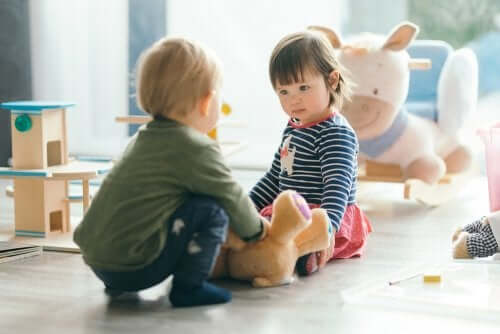The Importance of Repetition in Childhood Learning

Let’s take a moment to think about a child that’s learning to walk. He starts by crawling, then manages to stand up, and finally takes his first steps. He does this over and over again before actually mastering the task of walking independently. This is a clear example of the importance of repetition in childhood learning.
Children should learn fundamental abilities before they can acquire speed, trust, and mastery in any specific skill. Through repetition, the possibility of doing something becomes a real ability.
What is repetition in childhood learning?
When we’re talking about repetition, we’re not just referring to things like reading the same book, watching the same movie, or completing the same task over and over again. When we mention repetition, we’re talking about any type of work that offers children the opportunity to practice an ability or area of knowledge.

We can encounter repetition in many different ways. For example, it can mean reading the same story dozens of times or learning games that repeat the same ability. It can even mean passively observing a lesson or activity that another child is completing. But it always involves searching for a subtle and minimal change in order to progress.
It can also come from routine or environment. Knowing what’s going to happen and what things will occur in what order helps children know what to expect and to feel at ease. When an environment is predictable, children feel safe and protected, which creates an optimal environment for learning.
The science behind repetition in childhood learning
Childhood learning requires energy in order to develop neural connections. The less automatic something is, the more energy these connections require. In adults, these connections are already well-developed thanks to plenty of prior experience, repetition, and practice. This allows us to do things like drive a car or solve basic mathematical problems with very little effort.
In children, these neural connections are only just starting to form. So repetition is a necessary component that allows them to strengthen the connections in the brain. And these connections will help them to learn.
Why is repetition in childhood learning so important?
There are many reasons why repetition is so important as little ones are learning. Below, we’ll remind you of some of the most important reasons:
- Repetition helps to strengthen neural processors of the brain for learning.
- It teaches children to practice, master, retain, and reinforce knowledge.
- Repetition is necessary in order to master skills successfully.
- Children learn self-discipline and critical reflection through repetition.
- Through the repetition of movements, children improve their coordination.
- Repetition helps children learn to distinguish variations and differences in the world around them.
- Through repetition, children develop the confidence they need in order to progress.
- Repetition allows children to internalize concepts.
“Repetition is the secret of perfection.”
– Dr. Maria Montessori –
Not too much, but enough
In order for repetition to have any value, the activity, interest, or object with which children want to perform repetitions should have the right level of complexity. It should be complicated enough to allow for progression towards deeper and deeper levels of comprehension. But it shouldn’t be overly complicated.
Therefore, children’s books and music are perfect. They’re resources that children can go from experience to understanding. What’s more, they allow children to ask questions and start to predict future events. There is a world of learning in just one thing.

But be careful. You want to be sure not to use something so complicated that it disorients children. The precise place where you want to be is known as the Zone of Proximal Development.
“The Zone of Proximal Development is the distance we find between children’s real level of development, what they are able to do for themselves, and the level of developmental potential, what they are able to do with the help of an adult.”
In conclusion, there’s a reason why children love repetition so much during their first years of life. For little ones, it’s about more than just doing something more than once or twice. What may seem like a simple and repetitive activity to us, is a whole new world of learning for children.
Noticing that something is familiar makes them feel safe while they face a new world every single day.
Let’s take a moment to think about a child that’s learning to walk. He starts by crawling, then manages to stand up, and finally takes his first steps. He does this over and over again before actually mastering the task of walking independently. This is a clear example of the importance of repetition in childhood learning.
Children should learn fundamental abilities before they can acquire speed, trust, and mastery in any specific skill. Through repetition, the possibility of doing something becomes a real ability.
What is repetition in childhood learning?
When we’re talking about repetition, we’re not just referring to things like reading the same book, watching the same movie, or completing the same task over and over again. When we mention repetition, we’re talking about any type of work that offers children the opportunity to practice an ability or area of knowledge.

We can encounter repetition in many different ways. For example, it can mean reading the same story dozens of times or learning games that repeat the same ability. It can even mean passively observing a lesson or activity that another child is completing. But it always involves searching for a subtle and minimal change in order to progress.
It can also come from routine or environment. Knowing what’s going to happen and what things will occur in what order helps children know what to expect and to feel at ease. When an environment is predictable, children feel safe and protected, which creates an optimal environment for learning.
The science behind repetition in childhood learning
Childhood learning requires energy in order to develop neural connections. The less automatic something is, the more energy these connections require. In adults, these connections are already well-developed thanks to plenty of prior experience, repetition, and practice. This allows us to do things like drive a car or solve basic mathematical problems with very little effort.
In children, these neural connections are only just starting to form. So repetition is a necessary component that allows them to strengthen the connections in the brain. And these connections will help them to learn.
Why is repetition in childhood learning so important?
There are many reasons why repetition is so important as little ones are learning. Below, we’ll remind you of some of the most important reasons:
- Repetition helps to strengthen neural processors of the brain for learning.
- It teaches children to practice, master, retain, and reinforce knowledge.
- Repetition is necessary in order to master skills successfully.
- Children learn self-discipline and critical reflection through repetition.
- Through the repetition of movements, children improve their coordination.
- Repetition helps children learn to distinguish variations and differences in the world around them.
- Through repetition, children develop the confidence they need in order to progress.
- Repetition allows children to internalize concepts.
“Repetition is the secret of perfection.”
– Dr. Maria Montessori –
Not too much, but enough
In order for repetition to have any value, the activity, interest, or object with which children want to perform repetitions should have the right level of complexity. It should be complicated enough to allow for progression towards deeper and deeper levels of comprehension. But it shouldn’t be overly complicated.
Therefore, children’s books and music are perfect. They’re resources that children can go from experience to understanding. What’s more, they allow children to ask questions and start to predict future events. There is a world of learning in just one thing.

But be careful. You want to be sure not to use something so complicated that it disorients children. The precise place where you want to be is known as the Zone of Proximal Development.
“The Zone of Proximal Development is the distance we find between children’s real level of development, what they are able to do for themselves, and the level of developmental potential, what they are able to do with the help of an adult.”
In conclusion, there’s a reason why children love repetition so much during their first years of life. For little ones, it’s about more than just doing something more than once or twice. What may seem like a simple and repetitive activity to us, is a whole new world of learning for children.
Noticing that something is familiar makes them feel safe while they face a new world every single day.
All cited sources were thoroughly reviewed by our team to ensure their quality, reliability, currency, and validity. The bibliography of this article was considered reliable and of academic or scientific accuracy.
- Juan José Morales Ruiz. María Montessori y la educación cósmica. San Pedro, Montes de Oca. REHMLAC. 2016
- Maritza Pulido. Las rutinas en educación inicial: entre la mecanización y la transformación. Educación y ciudad 24. 2013
This text is provided for informational purposes only and does not replace consultation with a professional. If in doubt, consult your specialist.








